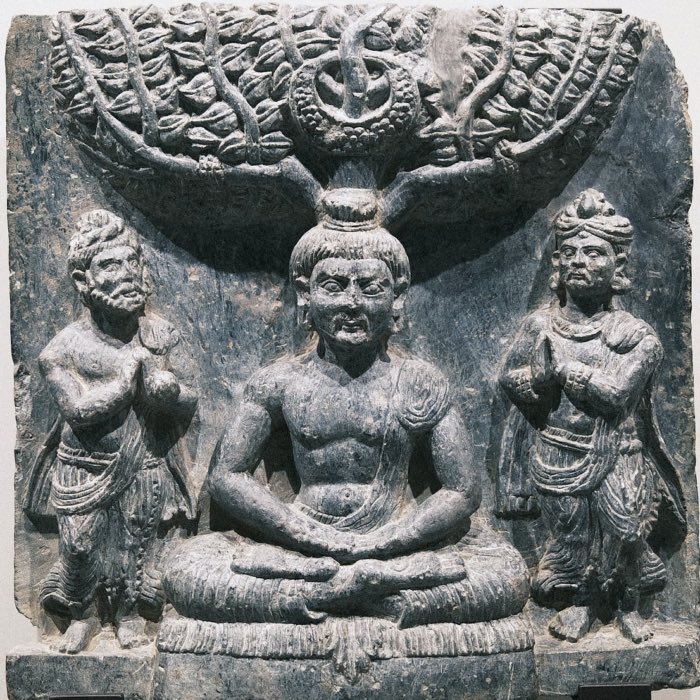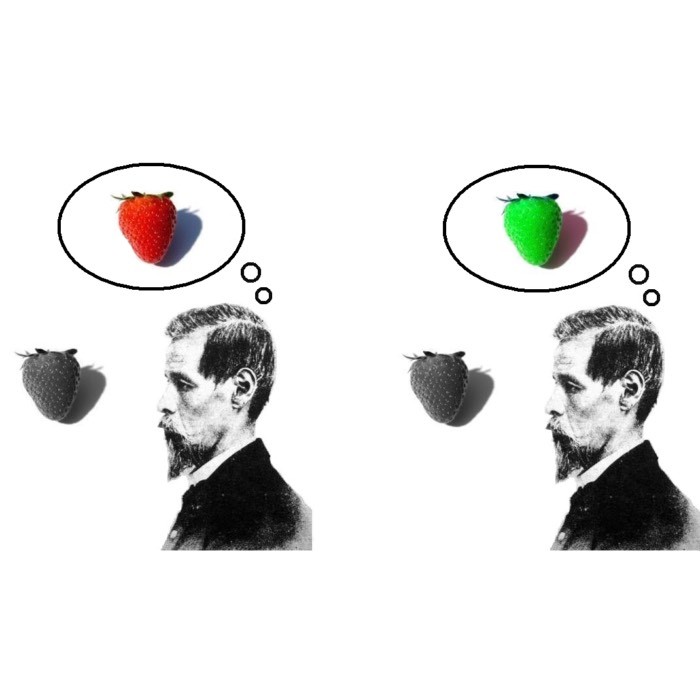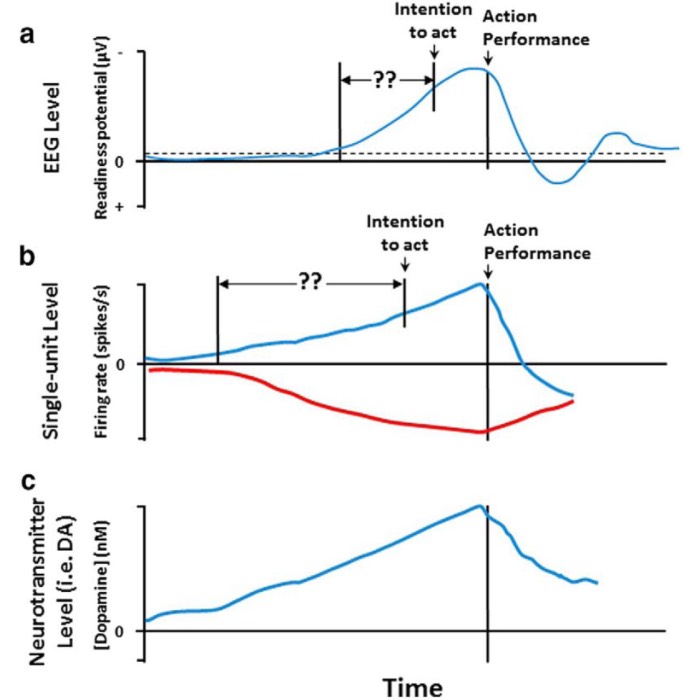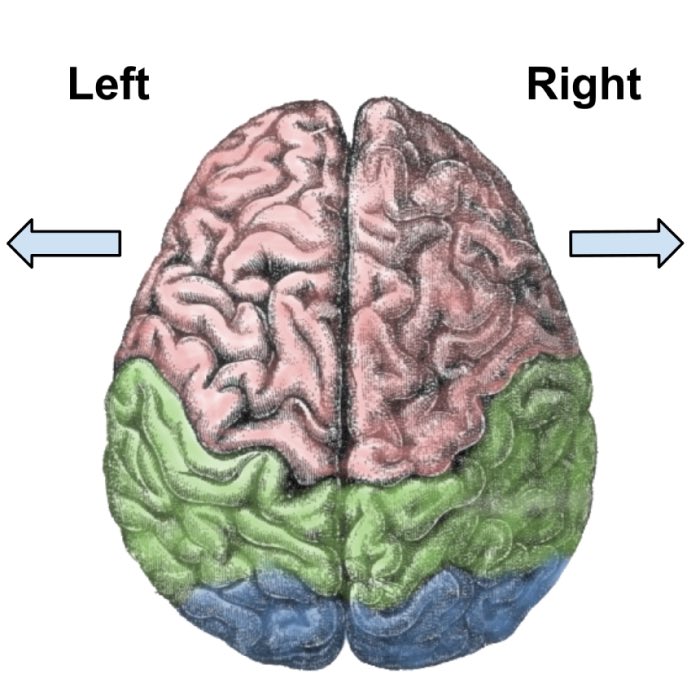The default mode network and the dissolution of ego
The experience of a solid, continuous self has long been assumed as an intrinsic feature of consciousness. However, both Buddhist philosophy and contemporary neuroscience challenge this assumption. In Buddhist thought, particularly in Siddhartha Gautama’s teaching of anattā (non-self), the ego is seen as a constructed and ultimately empty phenomenon. Recent findings in neuroscience, especially regarding the default mode network (DMN), lend empirical support to this view. In this post, we explore the relationship between the DMN, the sense of self, and the dissolution of ego, illustrating the remarkable convergence between ancient Buddhist insights and modern brain research.

Default mode network connectivity. This image shows main regions of the default mode network (yellow) and connectivity between the regions color-coded by structural traversing direction. Source: Wikimedia Commonsꜛ (license: CC BY-SA 4.0).
The default mode network: An overview
The default mode network, first systematically described by Raichle et al. (2001)ꜛ, consists of a set of densely interconnected cortical midline and lateral parietal regions, including the medial prefrontal cortex (mPFC), posterior cingulate cortex (PCC), retrosplenial cortex, precuneus, angular gyrus, and parts of the hippocampal formation. Functional connectivity studies using fMRI and MEG have revealed that these regions exhibit coherent low‑frequency oscillatory activity at rest, forming a large‑scale integrative system that dominates intrinsic activity in the awake brain. The DMN shows heightened activation during spontaneous cognition, autobiographical memory retrieval, mental time travel, narrative self-processing, counterfactual thinking, and broad internally oriented mentation (Buckner et al., 2008ꜛ). Recent high‑resolution imaging has further shown that subsystems within the DMN support distinct computations: a medial temporal subsystem linking episodic memory with scene construction, and a dorsomedial subsystem supporting conceptual self-reflection.
In contrast, when individuals engage in externally oriented, attention-demanding tasks requiring stimulus-driven processing, working memory, or executive control, DMN activity typically decreases, a phenomenon known as task‑induced deactivation. This reciprocal pattern is accompanied by increased activity in the fronto-parietal control network and dorsal attention network, indicating dynamic competition between internally and externally oriented processing modes. The DMN is thus closely associated with internally generated cognitive operations and plays a central role in constructing, sustaining, and continuously updating the personal narrative that anchors subjective identity across time.
The DMN and the construction of self
Neuroscientific studies have demonstrated that the DMN plays a central role in maintaining the sense of an autobiographical self. Andrews-Hanna et al. (2010)ꜛ proposed a functional differentiation within the DMN: a ventral medial subsystem involved in affective self-referential evaluation, and a dorsal medial subsystem subserving conceptual reflection on one’s traits, beliefs, and social identity. This architecture supports two core computational operations. First, self-referential processing integrates interoceptive, emotional, and mnemonic information into a coherent narrative model of the individual. Second, the DMN generates simulations of possible futures through hippocampal–cortical interactions, enabling predictive modelling, counterfactual thought, and long-term planning. These capacities collectively produce the phenomenological continuity of the self, linking remembered pasts with anticipated futures.
Moreover, abnormalities in DMN functioning have been implicated in psychiatric conditions characterized by distorted or unstable self-experience, including major depressive disorder, anxiety disorders, post-traumatic stress disorder, and schizophrenia (Whitfield-Gabrieli & Ford, 2012ꜛ). Hyperconnectivity or hyperactivity within the DMN is frequently associated with maladaptive forms of internally oriented cognition, including rumination, intrusive autobiographical recall, catastrophizing, and excessive self-criticism. In contrast, disrupted coherence of DMN activity in disorders such as schizophrenia correlates with fragmentation of self-boundaries, altered narrative identity, and impaired temporal continuity of experience. These findings underscore that while the DMN constructs a stable self-model, its dysregulation can distort or destabilize the very processes that normally underpin a coherent sense of self.
Meditation, DMN deactivation, and the dissolution of ego
Meditation practices, particularly those associated with mindfulness and non-dual awareness, have been shown to modulate DMN activity. Brewer et al. (2011)ꜛ found that experienced meditators exhibited decreased DMN activity during meditation compared to novice practitioners. Furthermore, experienced meditators showed greater connectivity between DMN regions and areas involved in cognitive control, such as the dorsolateral prefrontal cortex and dorsal anterior cingulate cortex.
In practices such as open monitoring meditation and non-dual awareness, the goal is not merely to reduce mind-wandering but to dissolve the habitual identification with thoughts and the narrative self. Judson Brewer and colleagues (2013) suggest that diminished DMN activity may underlie the subjective experiences reported by advanced meditators, such as the dissolution of ego boundaries and a sense of “selflessness.”
This reduction of DMN activity corresponds closely to Buddhist descriptions of insight into anattā. In the Saṃyutta Nikāya (SN 22.59, Anattā-lakkhaṇa Sutta), Siddhartha Gautama teaches that none of the Five Aggregates that constitute experience can be regarded as self. Meditation facilitates direct experiential insight into this non-self nature by weakening the brain’s default mode of self-referential narration.
Critical perspectives and open questions
While the association between DMN deactivation and experiences of non-self is compelling, several caveats must be noted. First, DMN activity is not inherently pathological; it supports necessary cognitive functions such as moral reasoning, theory of mind, and complex social interactions (Spreng et al., 2009ꜛ). Therefore, the goal of meditation is not to abolish the DMN but to regulate and integrate its activity more skillfully.
Second, the relationship between DMN modulation and subjective experience is complex and mediated by individual differences, such as meditation style, duration of practice, and psychological traits (Garrison et al., 2015ꜛ).
Finally, while Buddhist philosophy asserts the ultimate non-existence of a self, neuroscience remains a descriptive science that cannot make metaphysical claims. Nevertheless, the empirical findings support the Buddhist view that the experience of self is contingent, constructed, and subject to transformation.
Conclusion
The convergence between Buddhist teachings on non-self and neuroscientific findings on the default mode network offers profound insights into the nature of human consciousness. The DMN appears to underlie the construction of the autobiographical self, while meditation practices that reduce DMN activity correlate with experiential insights into selflessness. Recognizing the constructed and dynamic nature of the self opens pathways for psychological well-being and ethical transformation, aligning ancient contemplative wisdom with cutting-edge neuroscience.
References and further reading
- Andrews-Hanna, J. R., Reidler, J. S., Sepulcre, J., Poulin, R., & Buckner, R. L., Functional-anatomic fractionation of the brain’s default network, 2010, Neuron, 65(4), 550–562, doi: 10.1016/j.neuron.2010.02.005ꜛ
- Brewer, J. A., Worhunsky, P. D., Gray, J. R., Tang, Y. Y., Weber, J., & Kober, H., Meditation experience is associated with differences in default mode network activity and connectivity, 2011, Proceedings of the National Academy of Sciences, 108(50), 20254–20259, doi: 10.1073/pnas.1112029108ꜛ
- Buckner, R. L., Andrews-Hanna, J. R., & Schacter, D. L., The brain’s default network: Anatomy, function, and relevance to disease, 2008, Annals of the New York Academy of Sciences, 1124(1), 1–38, doi: 10.1196/annals.1440.011ꜛ
- Garrison, K. A., Zeffiro, T. A., Scheinost, D., Constable, R. T., & Brewer, J. A., Meditation leads to reduced default mode network activity beyond an active task, 2015, Cognitive, Affective, & Behavioral Neuroscience, 15(3), 712–720, doi: 10.3758/s13415-015-0358-3ꜛ
- Raichle, M. E., MacLeod, A. M., Snyder, A. Z., Powers, W. J., Gusnard, D. A., & Shulman, G. L., A default mode of brain function, 2001, Proceedings of the National Academy of Sciences, 98(2), 676–682, doi: 10.1073/pnas.98.2.676ꜛ
- Spreng, R. N., Mar, R. A., & Kim, A. S., The common neural basis of autobiographical memory, prospection, navigation, theory of mind, and the default mode: A quantitative meta-analysis, 2009, Journal of Cognitive Neuroscience, 21(3), 489–510, doi: 10.1162/jocn.2008.21029ꜛ
- Whitfield-Gabrieli, S., & Ford, J. M., Default mode network activity and connectivity in psychopathology, 2012, Annual Review of Clinical Psychology, 8, 49–76, doi: 10.1146/annurev-clinpsy-032511-143049ꜛ
- Wikipedia article on Default Mode Networkꜛ














comments